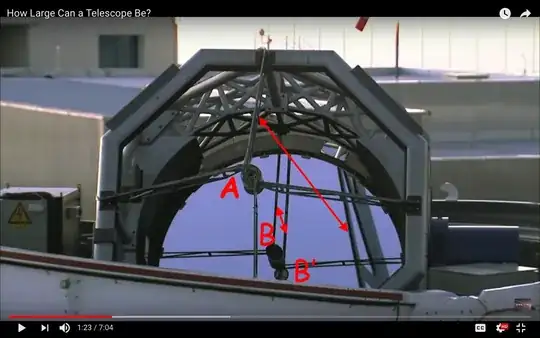I'm pretty sure this is one of the four auxiliary (or "outrigger") telescopes for the European Southern Observatory's Very Large Telescope Interferometer, part of the VLT complex at Paranal Observatory in Chile. It's used in conjunction with the four main 8 m ("unit") telescopes in an optical/infrared interferometric system, so its purpose is to send images of the sky in the optical or near-IR to be combined with images from the unit telescopes and the other auxiliary telescopes (via underground tunnels) in the interferometric system. (The octagonal gray frame is kind of a giveaway, and the fact that this video is ESO-based helps confirm this.)
https://www.eso.org/public/teles-instr/paranal-observatory/vlt/auxiliarytelescopes/
(Note that, per the link above, the primary mirror in each auxiliary telescope has a diameter of 1.8 m, while the secondary mirror is only 0.14 m -- very small, as you guessed.)
The object you identify as "B" is the tertiary mirror, which is flat, elliptical, and tilted at a 45-degree angle so that light from the secondary mirror is redirected off to the side. It sits in a mount (supported by the "B vanes") located just in front of the primary mirror, so there is no need for a hole in the primary mirror. You're probably used to versions of this (Nasmyth) design where the tertiary mirror is located behind the primary mirror, requiring a hole in the primary. Since the tertiary mirror in a Nasmyth design needs to sit along the elevation rotation axis of the telescope, whether it goes in front of or behind the primary depends on the overall telescope balance.
(Sometimes there is a hole in the primary, and the tertiary sits on top of a small "tower" that protrudes up through the hole from behind the primary; this would help disguise the existence of the hole. That's how the tertiary mirrors in the 8 m unit telescopes of the VLT work, though I don't think they have support vanes the way this one does. The existence of the support vanes and the nature of the B' reflection suggests there really isn't a hole in the primary here.)
The "dome" is an example of a "clamshell" design, in which two halves fold down out of the way; you can see one of the two hinges in the front, near the bottom right of your images. If you google for images of these telescopes, you can see them in the daytime, folded-up configuration.
Here's an image of one of the telescopes when it was still in the factory (before the mirrors were installed), which may help you understand the design better:


